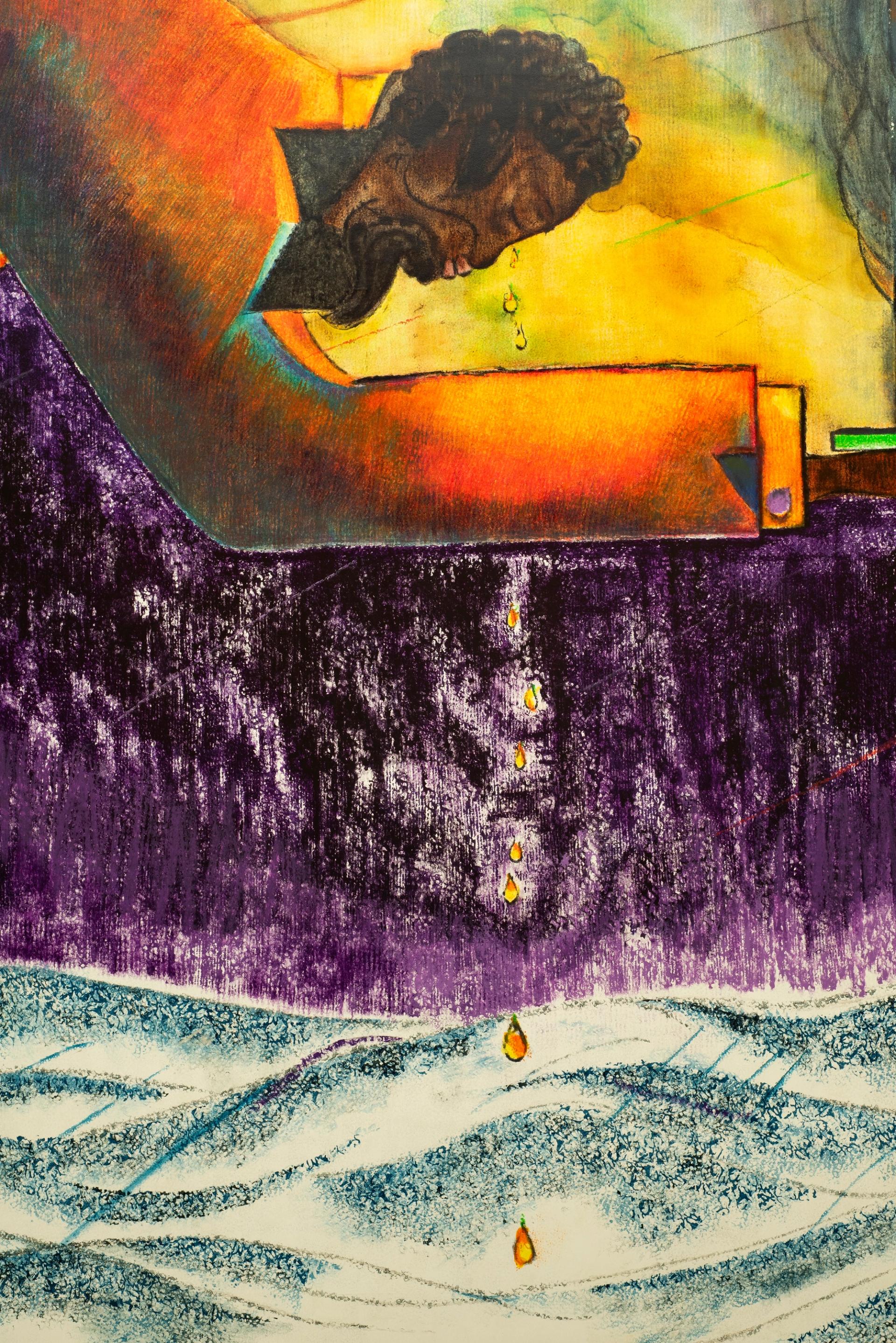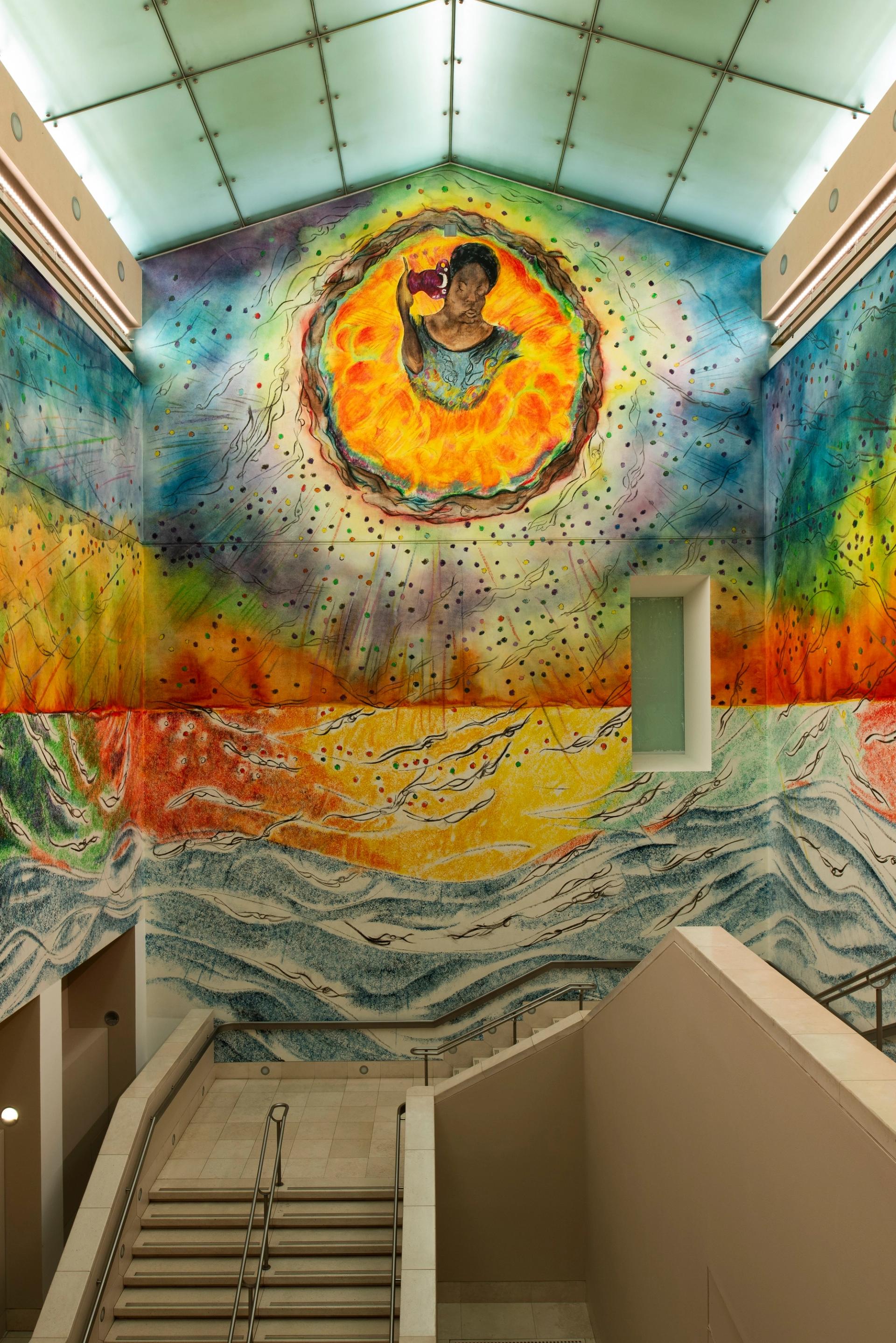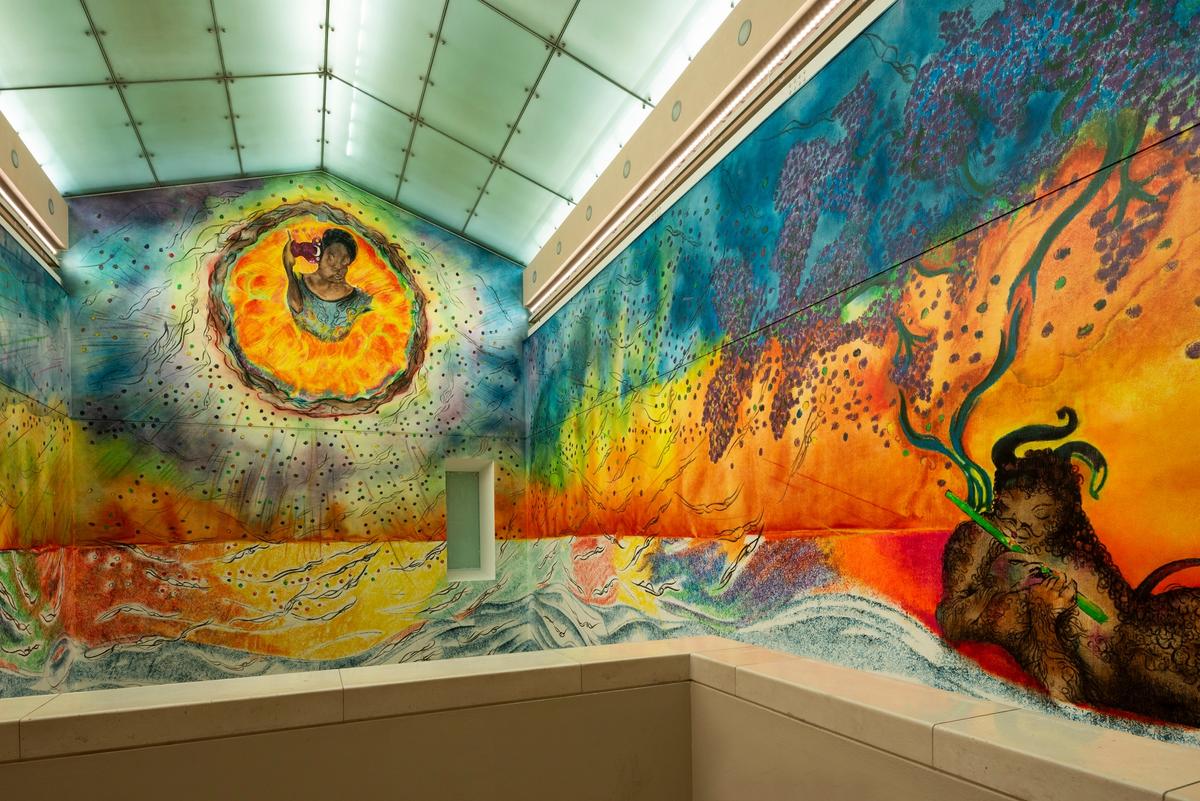The artist Chris Ofili has unveiled a new site-specific work at Tate Britain commemorating the Grenfell Tower fire. The vast mural, entitled Requiem, unfolds in “three chapters” over the gallery’s North Staircase, with the central section dedicated to the Gambian-British artist Khadija Saye who died in the fire.
In June 2017, 72 people died in the blaze which broke out in the 23-storey tower block located in west London. Ofili’s provocative work opens to the public today following private viewings for Saye’s family and the Grenfell community earlier this month, a Tate statement says.
“Public art can hold spaces of grief and it can keep alive collective memories of events that might otherwise completely just fade away in time,” Ofili says in an audio piece available on the Tate website (a transcript is below). “As a whole I intend the mural to invite reflection on loss, spirituality and transformation; particularly these elements are important to me today in 2023 as we are waiting for the final report on the Grenfell enquiry to be published.”

Chris Ofili's Requiem, 2023 (detail) commissioned for Tate Britain’s north staircase
© Chris Ofili. Courtesy the artist. Photograph: Thierry Bal
Ofili’s mural is divided into three parts. Chapter one (Look. Look at this. Look at what we’ve done. Look at what is happening) depicts a bowing figure described as a “prophet or witness”. He appears to hold the burning tower, conducting a ceremony of loss.
Chapter two (Change and transformation) shows Saye high up on the middle wall, holding an andichurai (Gambian incense pot) to her ear. Chapter three (A place for redemption, healing and hope) shows two mythical beings making music in a paradise setting. The work will be on display for ten years; Requiem replaces David Tremlett’s Drawing for Free Thinking (2013) which was previously on display in the staircase.
Khadija Saye grew up in Ladbroke Grove in West London and lived on the 20th floor of Grenfell Tower. In 2017, she showed a series of photographic self-portraits (Dwelling in this space we breathe) in the Diaspora Pavilion at the Venice Biennale in 2017. Ofili briefly met Saye in Venice with the encounter having a “profound impact” on him, a Tate statement says. Saye’s mother, Mary Mendy, also died in the fire.

Chris Ofili's Requiem, 2023 (detail) commissioned for Tate Britain’s north staircase
© Chris Ofili. Courtesy the artist. Photograph: Thierry Bal
Phase one of the government inquiry into the Grenfell Tower disaster ended in 2019. Phase two of the inquiry closed last November after 400 days of evidence; the findings are due to be published later this year. Richard Millett KC, the counsel to the inquiry, used his final statement to declare: “Each and every one of the deaths that occurred in Grenfell Tower, on the 14 June 2017 was avoidable.”
Requiem was supported by the Chris Ofili Commission Supporters Circle, the patrons Andreas and Ulrike Kurtz, the galleries Victoria Miro and David Zwirner and other anonymous benefactors.
Earlier this year the Turner prizewinner Steve McQueen showed his film about the Grenfell Tower fire at the Serpentine Galleries in London. The 24-minute work, which was self funded by McQueen, will enter the collections of the Tate and the Museum of London.
Full transcript of Chris Ofili's audio piece:
“The piece remembers the tragedy of Grenfell and the fire that occurred in June 2017, and pays tribute to Khadija Saye, an artist who lived in the tower and died there along with her mother Mary Mendy. I knew that I wanted to make a work that would say, remember this, and it needed to be direct in the way that it treated the subject matter so I broke it down into three parts, three walls, three separate drawings that somehow would come together to be this one complete work.
I conceive of the bowing figure on the left… as a witness and he is presenting Grenfell Tower burning with the reverence of someone that is conducting a ceremony of loss or a requiem, carefully, and with respect and with emotion which is released in his tears falling into a river or an ocean that is accumulating below him of despair. I see it as a tender, trembling, respectful and dutiful act that he is performing. From there, I visualised the spirits of souls that move away from the tower, and escaping.
[In] the second chapter of the mural, the focus is on portraying Khadija Saye who is the artist I met and who was killed in Grenfell Tower. This image is taken directly from one of her self-portraits that Khadija was exhibiting in Venice in the Diaspora Pavilion at the same time that I met her in 2017.
I was coming back from a trip to Venice after doing another exhibition there, and we passed the remains of Grenfell Tower, wrapped. And it wasn’t the first time that I’d seen it. Before I always found that I always looked away instinctively quite soon after looking at it, but this time I became quite self conscious of that, so I decided that I was going to continue looking and my memories of first meeting Khadija in 2017 shortly before she was killed in the fire in June came flooding back in and began to crystallise in my thoughts.
These thoughts of just utter discomfort, almost physical feelings of looking at something and being reminded of something that was really terrible; all those feelings started to surface in my mind. And I felt that the luxury of being able to indulge in looking at something and then being able to look away, that luxury was no longer tenable. I actually had to start to face up to that discomfort.
So I would say it was precisely at those moments of looking that the subject matter of the mural fell into place. I felt that I could grab on to the idea that the mural could reflect what had happened in Grenfell but it did make me realise that in order for something like that to never happen again, we have to be reminded that it did. Public art can hold spaces of grief and it can keep alive collective memories of events that might otherwise completely just fade away in time, just as life inevitably moves on.
So the body of water, it flows across the entire mural and is a way of linking Venice and London and a way of symbolising the shared connection that I had with Khadija. Somehow [it is] trying to honour this brief meeting and the power, or energy, or charisma that I felt about her and unfortunately now has just become an emotional memory for me. It’s both a kind of collective grief around her loss as an individual and an artist. In the self-portrait, she’s holding a vessel up to her ear, it is a Gambian incense pot which is traditionally used to drive away evil spirits from the home. It is a precious object that honours her dual faith heritage of Christianity and Islam, and I suppose because of that it’s charged with personal meaning. In the central section, the spirits of souls come together as an energy force and they are drawn to and converge around this source of radiance or magnetism with Khadija’s image at its centre.
Moving then into the third chapter of the mural you see the spirit of souls drawn towards a more Edenic landscape of hope, redemption and hopefully extraordinary peace, and you see the colours of the burning tower transformed into those of a warm sunrise or sunset. All the way on the right-hand side, there is a purple tree and this manifold spirit of souls start to converge and settle in and around this flowering tree-like shrub which is based on a plant called ceanothus, which grows in a garden dedicated to Khadija’s memory.
Underneath the tree there you’ve got this singular, but in my imagination, I imagine many mythical faun-like creatures lying and resting up in the shade of that tree playing music, and that sound or that melody drifting across the water and horizon, almost calling the spirit of souls into a place of peace.
When I talk about the piece now and picture it and look at it, I feel an important part is this horizon that runs all the way across; it is an artistic device to create a boundary that divides the sky from the water but also separates the earth and the realms beyond earth. As a whole I intend the mural to invite reflection on loss, spirituality and transformation; particularly these elements are important to me today in 2023 as we are waiting for the final report on the Grenfell enquiry to be published, and campaigners fight for its phase one recommendations to be implemented, and as the criminal investigation into the fire’s deadly spread is still ongoing.
I think I hope the fact that it’s painted directly on to the walls of a public museum will allow it to speak across time in a very direct way and I think it’s important that in some ways that this work isn’t something that’s transportable, and the impact of the life of it on the walls will remain and will pass through people’s minds and memories.
And I had to go through in a different way emotions, researching and putting the image together, [they] were sometimes extremely tearful, very difficult and contradictory. I wouldn’t really discount any reaction that anyone might have to the mural but I do hope it will give the opportunity to really look and feel and be aware of emotional responses—anger, sadness and any other emotion is valid and relevant. Emotions change and opinions change over time but this work will stay the same. I hope it prompts a collective paying attention to a devastating historical event.”


